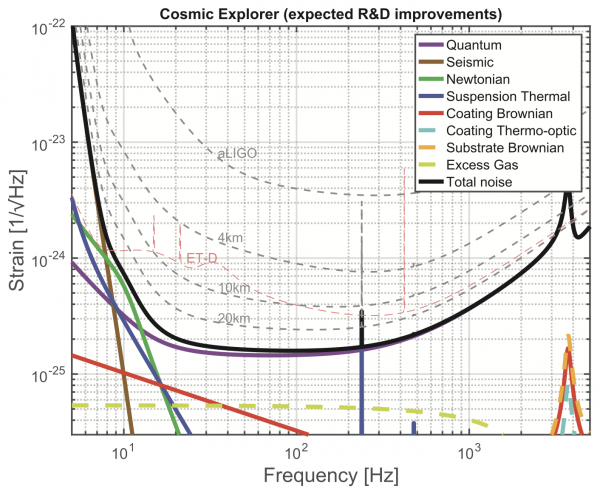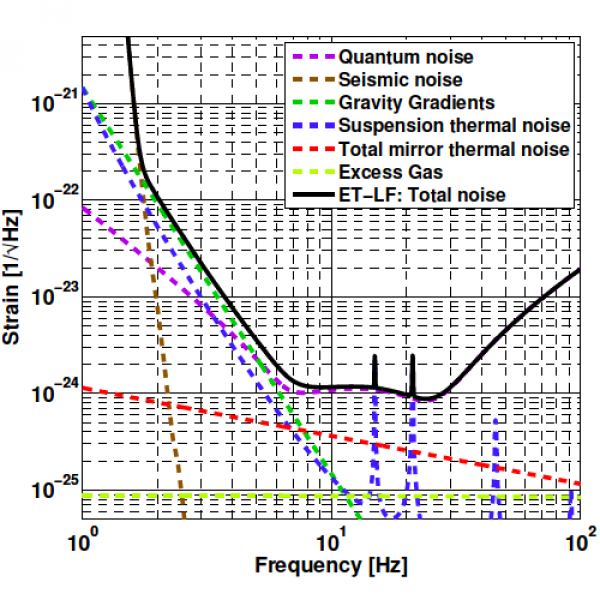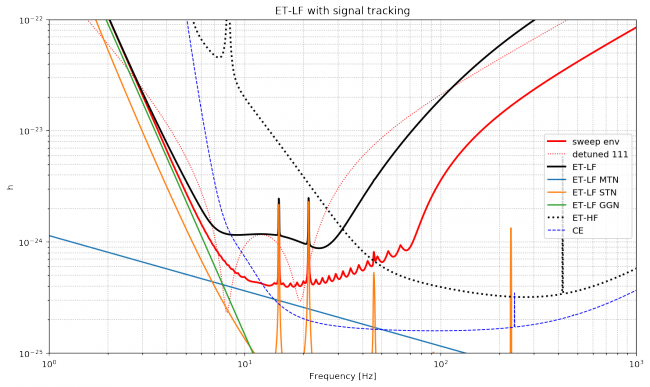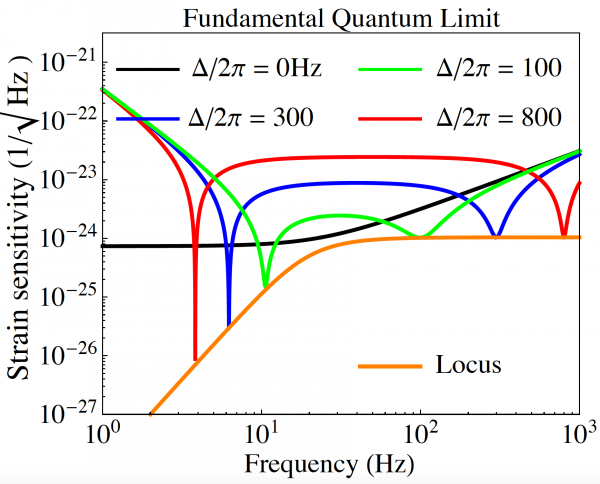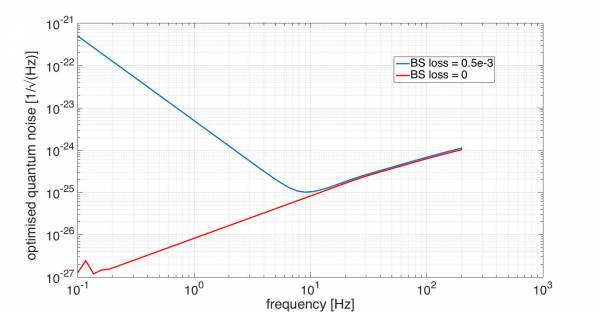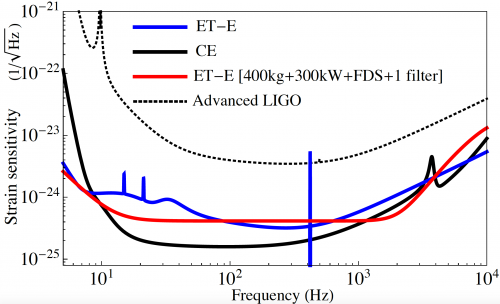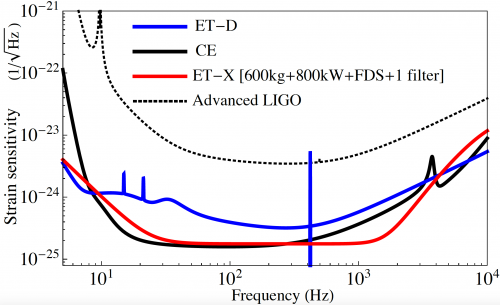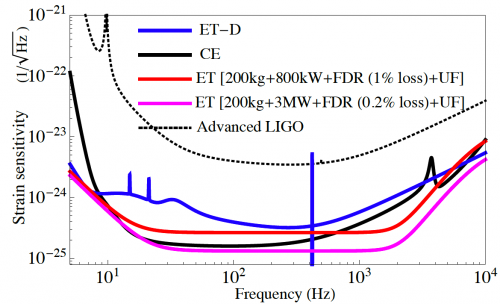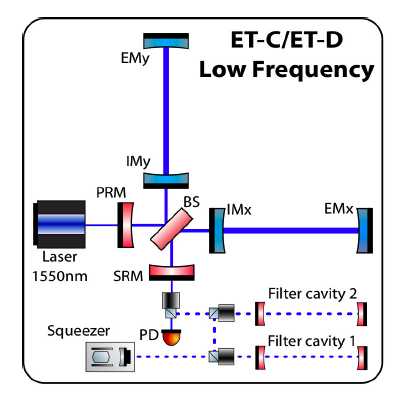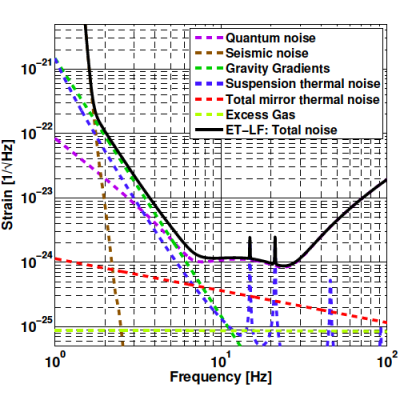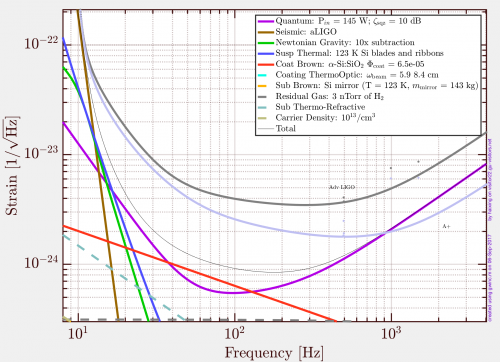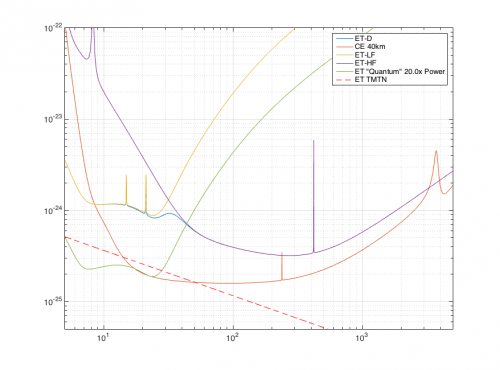ET Low-Frequency Quantum Noise
(Daniela, Jennifer, Haixing, Omar, Peter, Vaishali, Sebastian)
Summary & Next Steps
- keeping ET-LF+HF, we have the option of increasing the low-frequency sensitivity significantly by using dynamic detuning or unstable filters
- GWINC model to be finished
- what would be the requirements for such a filter?
- is background collection / sensitivity calibration an issue?
Motivation
Looking at Cosmic Explorer preliminary designs, we see that ET-D performs very well at both high and low frequencies, but there is an intermediate range at around 20-80Hz where the sensitivity curve has a distinct 'bump':
Also, the classical noise in ET-LF is quite a bit below the quantum noise, which seems like a waste of resources:
Now, unfortunately we cannot (?) significantly increase the power without losing the 20K operation. Losing 20K also almost certainly means we lose low-frequency (< 10Hz) sensitivity completely. A 120K, non-xylophone configuration was the topic of the Xylophone Congiguration working group, so we don't want to look at it here. Instead, we look at what tricks we can play to increase (in ET or as a subsequent ET+ upgrade) the low-frequency sensitivity.
There is an ultimate quantum limit that we can reach with any passive topology. We can approximate this with a dynamic tuning of the SR cavity (ET timescales?), or with “fancy quantum filters” inside the SR cavity (ET+ timescales?). At low frequencies, inspiral times are ~100-10000 seconds, as shown by the 7Hz/20Hz group. Therefore, dynamic signal-recycling detuning might not be completely out of question (popular opinion will vary).
Drawbacks:
- getting detection background?
- calibration of sensitivity?
- PIs?
- Stefan Danilishin's point: EPR-style filtering can only replace a single FC (already applies to ET-D).
Modelling
Scripts are located in a Git repository: ET-LF-design-review.
Finesse
- finesse model based on Vaishali's code,
ET_LF_SqueezePath.ipynb - removed filter cavities and squeezing, simply scaled everything by sqrt(10) for ~10dB detected squeezing
- changed SR reflectivity from 0.8 to 0.92 (gives better sensitivity, and because we can)
- overall sensitivity will be given by locus of all detunings, here we hack this together by calculating a few curves and taking the overall minimum – thus there are severe artefacts.
- red dashed curve gives example for one particular detuning
GWINC
Conclusion
- Haixing has been working on a theoretical model to show how the minimum QN changes if you optimise the detuning of the SRC and the readout quadrature over the frequency range for ET-LF. The locus shows the fundamental limit on the QN sensitivity for sweeping the detune frequency of signal-recycling cavity.
- Omar, Daniela and Jennifer have been working on making a match for this theory using the Cryogenic voyager gwinc model (Rana Adikhari et. al. CryoLIGO) and code that optimises the QN over the same frequency range according to the parameters above. We altered the length to fit the ET single detector length.
Next Steps [from last meeting]
- We (Omar,Daniela,Jennifer) need to get the case with no optical losses to match the theory, then we will incrementally add in realistic losses (possibly from the design study or updated losses if we have them) and show the best possible case for ET-LF QN assuming we can tune the SRC and readout quadrature in-situ.
- This needs to be carried out for a range of realistic SRM transmittivities so we can make a recommendation for the one that gives us the best sensitivity.
- Some further work is needed as we are having trouble matching the theoretical curve at low frequencies.
High-power options
If we can increase the optical power for ET-LF, instead of detuned operation mentioned above, we can use the tuned configuration and apply an unstable filter to broaden the bandwidth of ET-LF, and cover the sensitivity by ET-HF.
Below are two examples:
Both assume 10dB frequency-dependent squeezing and adding one unstable filter. The transmission of SRM are 0.1 and 0.05 respectively.
We can also remain the mass and to cancel the low-frequency radiation pressure by either using speed meter or the frequency-dependent readout together with frequency-independent squeezing. Below is the example of frequency dependent readout with 1% loss for the mode-matching to the filter cavity. [Note: the result is preliminary. It needs further optimisation and validation. Our UoB students Joe Bentley and Philip Jones will work on this.]
Older Stuff
Older stuff below.
Review of existing design
Configuration
| Mass | Wavelength | Material | Intra cavity power | arm length | ITM (transmission) | ETM (transmission) | SRM (transmission) | loss |
| 200kg | 1550nm | Silicon | ~18kW | 10km | 7000ppm | 6ppm | 0.2 | 37.5ppm |
Target
Classical noise budget
- ET (at least comparable to CE QN at low frequencies)
- LIGO Voyager (4km) voyager_classical_noise.mat (worse than ET at low frequencies)
TODO
- Push ET-LF sensitivity [GWINC optimisation]
- increase power & squeezing
- signal-recycling with frequency-dependent readout
- speed meter
- unstable filter (white light cavity effect)
- Push ET-HF sensitivity
- signal-reacyled with frequency-dependent readout
- speed meter
- Fundamental quantum limit
- how much power fluctuation needed at different frequencies
- power & squeezing & recycling gain & loss
Tasks for GWINC group
- GWINC code for signal recycling quantum noise curve
- optimisation code
- modified parameters: detuning phase, readout angle, SRM transmission (0.2, 0.02, 0.005)
Approaches to improving low-frequency sensitivity
- higher power (how about the coating thermal noise?)
- internal (ponderomotive) squeezing and external squeezing
- higher signal-recycling gain
- frequency-dependent readout
- speedmeter
Approaches to extending high-frequency sensitivity
- xylophone design
- unstable filter
Ideas from Plenum for what to present at end of workshop
- Optimise low f sensitivity for xylophone.
- optimise single detector to match low frequency using combination of techniques.
